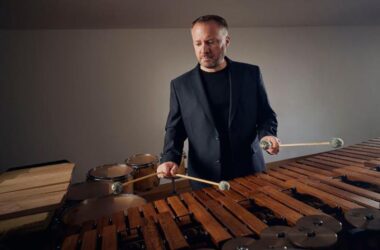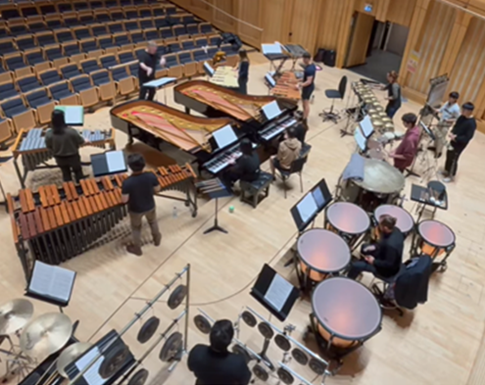 United Kingdom Higdon, Pereira, Wuorinen, Big Bash 2025: Colin Currie & RWCMD Percussionists: Dora Stoutzker Hall, Royal Welsh College of Music and Drama, Cardiff, 21.3.2025. (GP)
United Kingdom Higdon, Pereira, Wuorinen, Big Bash 2025: Colin Currie & RWCMD Percussionists: Dora Stoutzker Hall, Royal Welsh College of Music and Drama, Cardiff, 21.3.2025. (GP)

Jennifer Higdon – Splendid Wood
Joe Pereira – Vow
Charles Wuorinen – Second Percussion Symphony
The internationally renowned British percussionist Colin Currie recently spent some time in Cardiff, working with percussion students from the Royal Welsh College of Music and Drama. One of the outcomes was this lunchtime concert made up of works entirely for percussion by three composers from the USA – in order of their birth Charles Wuorinen (1938), Jennifer Higdon (b.1962) and Joe Pereira (b.1974). The concert turned out to be an exhilarating and fascinating experience which demonstrated, amongst other things, just how various music for percussion can be.
On entering the hall before the concert we were greeted by a stage packed full of a variety of percussion instruments: timpani, marimbas, xylophones, drums, chimes, crotales, almglocken, gongs, chimes and two pianos. Considering all this, I recalled the observation made by the jazz critic Val Wilmer that Cecil Taylor (one of the great musicians of Free Jazz) played the piano as though it were ‘eighty-eight tuned drums’.
The programme opened with Jennifer Higdon’s Splendid Wood, a piece commissioned in 2006 for the New England Conservatory Percussion Ensemble. It is performed at three marimbas, with two musicians playing each of the marimbas. The six players on this occasion were Carys Underwood, Camilla Chiu, Markus Hoppe, Rui De Sousa Stayton, George Garnett and Owen Gunnell. The title suggests that Higdon wishes to praise (and celebrate) the very nature of the marimba – that in striking wood we release ‘splendid’ sounds and that this was surely amongst the earliest ‘musical’ sounds that people made. Her work, which is shot through with a love for the very sound of wood being struck, is full of shifting patterns of sound which don’t appear to be ‘confined’ by bar lines etc, but to have a far more organic structure – (I have in mind the contrast between ‘mechanical’ and ‘organic’ form made by Romantics such as Coleridge). Higden’s subtle music, full of overlapping rhythms from the three marimbas (and the six mallets playing each marimba) suggests ways in which the wood continues to ‘live’, though now part of a musical instrument. This was a delightful piece, very well played, in terms both of precision and sensitivity, by the six young musicians.
The second piece on the programme, Joe Pereira’s Vow, took us from the world of wood to that of metal, being written for two glockenspiels. Pereira is a distinguished percussionist, being, since 2008, Principal Timpanist of the Los Anggles Philharmonic. His website includes a fascinating note on Vow, which I will quote in full, since though relatively lengthy, it says much better than I could how the piece works its magic:
‘The idea of this piece was to take only a handful of pitches, repeated in cell like patterns on two different glockenspiels, which naturally have contrasting overtones. These sonic conflicts give the illusion of other pitches appearing as clouds of sound, resonating over the played notes. From the players [sic] standpoint, disruption of natural resonance is at the forefront and various uncommon techniques are used to manipulate the sound. Quick muffling with hand or mallet dampening, causes an almost electronic sounding effect of echo/delay, and can make pitches bend in unexpected ways. Buzzing lighter flexible mallets on the bars, creates a granular resonance, imitating the decay of sound, and at times, again sounding as if it is an electronically manipulated sound in reverse. It’s not until the very end of the piece when we’re left with a halo of natural resonance in a tonal echo.’
The two performers, Owen Benoy and George Garnett, gave a sure-handed performance of the piece – less than seven minutes long, but full of complexities and unearthly sonorities. The effect it had on me was comparable to some minimalist music, and to some Eastern European Church music.
The concert closed with Charles Wuorinen’s Second Percussion Symphony. His [first] Percussion Symphony was composed in 1970. This Second Percussion Symphony was written in 2019 and seems, sadly, to have been the last work Wuorinen completed before his death in March 2020. The earlier percussion symphony was scored for some 24 performers and lasted around 40 minutes in performance. This second such symphony requires a minimum of 14 performers, though 16 performers were employed here (presumably to avoid excessive doubling of instruments) and it is somewhat shorter – at around 24/25 minutes it is some 15 minutes shorter than its predecessor. That earlier work was in three distinct movements, whereas this later symphony is in one long movement; yet it would be very wrong to think of it as a kind of ‘chamber’ symphony. That idea is effectively dismissed by the explosively loud tutti which opens the work. This Second Percussion Symphony was, it seems, premiered in Miami in September 2024 and this Cardiff performance was its European premiere. The performance was conducted by Colin Currie, in his only appearance on the stage during the concert; he prefaced the work with a short speech in which he praised the students for their work, during his spell in Cardiff.
The Second Percussion Symphony proved to be an exciting and enjoyable ride, with many variations in dynamics and changes of rhythm and texture, though an overall shape was always discernible. It is perhaps invidious to single out individual performers for praise, but I feel obliged to say that I was greatly impressed by the work of vibraphonist Carys Underwood and by that of the two pianists, Stephanie Cheung and Yiwen Gul.
A rewardingly challenging concert for which I was very pleased to have delayed my lunch.
Glyn Pursglove
Featured Image: Colin Currie conducting the RWCMD Percussionists in Charles Wuorinen’s Second Percussion Symphony

I thoroughly agree with Glyn Pursglove’s review. The first two pieces both owed a debt to minimalism while Wuorinen’s symphony was a throwback to old-school modernism. Together they comprised a very satisfying programme.
The student ensemble’s confident performance showed that standards of percussion playing are higher now than they have ever been.